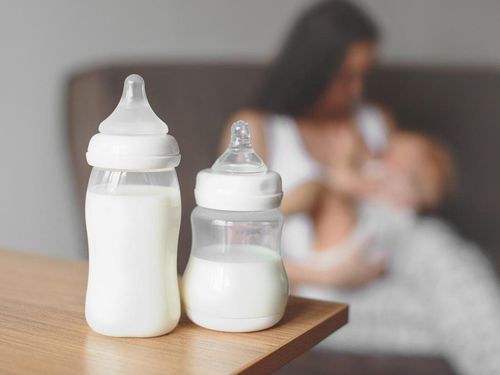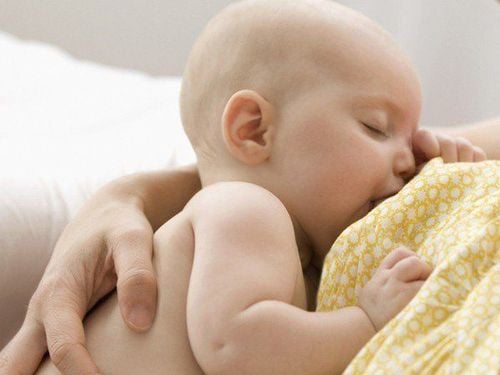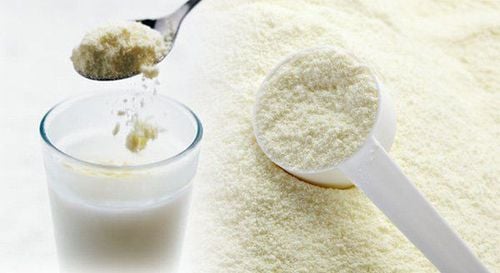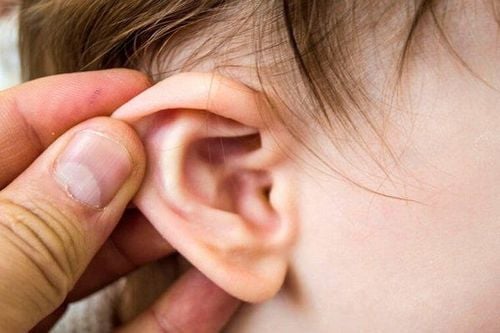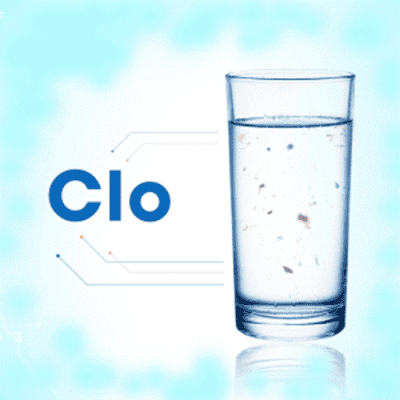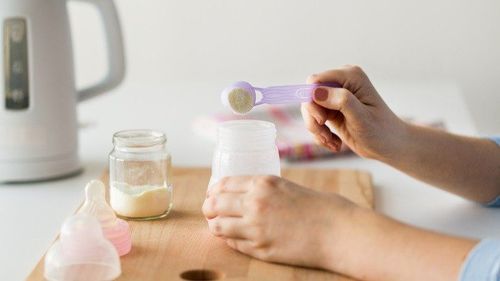This is an automatically translated article.
The article was professionally consulted with Master, Doctor Phan Ngoc Hai - Doctor of Pediatrics - Neonatology - Department of Pediatrics - Neonatology - Vinmec Danang International General Hospital.Unpasteurized infant formula can contain bacteria that can cause serious illness in babies. By preparing and storing infant formula properly, you can reduce your baby's risk of illness.
Breastfeeding is best, the World Health Organization (WHO) recommends that babies should be exclusively breastfed for the first 6 months of life. Exclusively breastfed babies have the best start to growth and development and health. In cases where breastfeeding is not possible, such as a mother who is taking medication that is contraindicated for breastfeeding, or a mother with HIV infection or a mother who does not have enough milk to breastfeed, a suitable breast milk substitute is required. for example infant formula.
The most important thing is proper preparation and good storage to reduce the risk of disease.
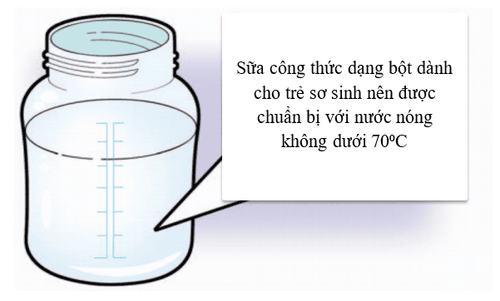
1. General requirements for preparing infant formula in infant care
Infant formula should be selected based on the child's needs. Where available, the use of pasteurized liquid formula is the method recommended by experts as the risk is minimal.For areas where sanitation and clean water are not guaranteed, cup feeding is a safer option than bottle feeding. This is because the knobs and corners of bottles are often harder to clean and can be a place where harmful bacteria can grow and cause illness in babies.
In each locality, the World Health Organization recommends developing separate written guidelines for the preparation, preparation and storage of infant formula that are appropriate to the conditions, environment and culture. of each specific region. Healthcare workers should also be adequately trained in the guidelines for hygiene requirements when handling food and infant formula and these instructions should be closely monitored.
Preparation of infant formula also needs to be done in an area dedicated to preparing and storing milk, ensuring hygiene and using a dedicated hand wash basin for preparation stages.
If formula is prepared but not used immediately, it should be stored in a refrigerator specifically designed for milk storage. The temperature of the refrigerator should not exceed 50C and should be regularly monitored until it is used by children.
Another important thing parents or carers should keep in mind when choosing infant formula is full traceability of all formulas formulated. This means that these types of milk need to be labeled with full information such as: type of formula, manufacturer's name, appropriate age of the child... in accordance with the regulations of each country.
2. How to clean, disinfect and preserve milk and baby preparation items
It is very important that all utensils used to prepare milk as well as feed the baby such as cups, bottles, nipples, lids, spoons... must be thoroughly cleaned and sterilized before use. use. Cleaning and sterilizing these items eliminates harmful bacteria that can grow during the preparation of infant formula.2.1. Clean
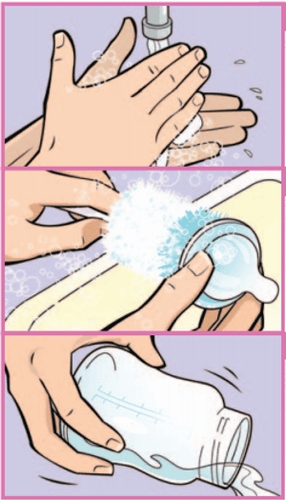
Step 1: Wash your hands with soap and water, then dry with a sterile handkerchief. Step 2: Wash all utensils used for preparing and feeding children with soap and hot water. Use a sterilized brush to scrub both the inside and outside of bottles, jars, and teats to ensure that all bacteria are removed, even in the most hard-to-reach areas. Step 3: Rinse the items again with clean water. 2.2. Sterilization Feeding and preparing utensils for children need to be cleaned and disinfected with
Sterilizers: If using a sterilizer, follow the manufacturer's instructions. Common types of sterilizers today include electric or microwave steam sterilizers and chemical sterilizers. Pans and boiling water: In case of using pots, pans and boiling water for sterilization, the following steps should be followed:
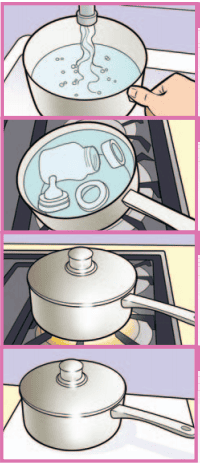
Step 1: Fill a large saucepan or saucepan with water
Step 2: Place utensils to be sterilized in the water, making sure they are completely covered with water and no air bubbles appear
Step 3: Cover the pot or pan and bring to a boil, making sure the water in the pan does not evaporate
Step 4: Cover the pan until it is time to prepare baby formula
2.3. Storing sterilized utensils To prevent re-contamination, it's best to remove utensils from the sterilizer or pan just before use. If tools are removed earlier, be sure to leave them in a clean place. Close the cap of the bottle immediately after taking it out to prevent bacteria from entering the bottle as well as the teat. Wash hands with soap and clean water and dry before sterilizing.
3. How to prepare formula for bottle-fed babies Mixing formula for bottle-fed babies should follow these steps:
Step 1: Clean and disinfect the surface where formula is being prepared. Step 2: Wash your hands with soap and clean water, then dry them with a hand towel or sterile cloth Step 3: Boil a liter of clean water. If using an automatic kettle, wait until the off button is pressed. If using a saucepan, make sure the water reaches a boiling point. Step 4: Read the instructions on the formula packaging to calculate the amount of water and formula to prepare. More or less milk in formula is not good for babies. Step 5: Be careful, avoid burns, pour the right amount of boiled water (cooled down to no less than 70 degrees Celsius) into the sterilized milk bottle. Use a clean, sterile thermometer to check the temperature Step 6: Add the correct amount of formula to the bottle Step 7: Stir until the powder is completely dissolved in the water by gently shaking or rotating the bottle Step 8: Cool immediately Immediately bring the baby to an edible temperature by holding the water bottle under cold running water or placing the bottle in a container of cold water or ice. Step 9: Dry the outside of the bottle with a clean cloth or handkerchief Step 10: Check the temperature of the prepared milk by placing a small amount of milk on your wrist. If the temperature feels warm enough, feed the baby immediately. If it's still hot, cool it down a bit more Step 11: Feed the baby Step 12: If the baby doesn't finish it, the leftover milk should be kept for a maximum of about 2 hours. After that time, empty the remaining milk.

4. How to store prepared formula
The safest way is to prepare formula for each feeding and consume immediately. However, in some cases, bottles need to be prepared in advance and stored in the refrigerator for later use. The following steps are the safest method to store the reconstituted milk for future use:Step 1: Prepare the milk in individual bottles by following the instructions for preparing infant formula. bottle feeding described above Step 2: Place the pre-mixed and cooled formula bottles in a dedicated refrigerator. The temperature of the refrigerator should not exceed 50°C and should be monitored until the milk is ready for use. Step 3: Store milk for up to 24 hours. After this time, the baby should not use milk in the bottle anymore.
5. How to re-warm stored milk bottles
Warming bottles of milk stored in a dedicated refrigerator should follow these steps:Step 1: Remove the bottles from the refrigerator the day before they need to be used Step 2: Rewarm for no more than 15 minutes. Milk can be reheated using a bottle warmer or placing the bottle in a container of warm water, making sure the water level is below the cap. Shake occasionally to keep the milk in the bottle warm. Step 3: Check the temperature of the milk in the bottle by placing a small amount on your wrist. Babies can eat immediately if the milk feels warm, not hot. Step 4: Feed the baby Step 5: Reheated milk should be given to the baby within 2 hours. After this time, the excess milk should be discarded. Newborns are generally susceptible to respiratory diseases, respiratory infections and gastrointestinal infections if they are introduced to solid foods early or are not properly stored and prepared. To protect children's health, parents should do well to exclusively breastfeed their babies for the first 6 months (if possible) and vaccinate on schedule. As soon as the child shows symptoms such as anorexia, fatigue, crying, it is necessary to take the child to the hospital to be consulted by a specialist for monitoring and treatment. The pediatric department at Vinmec International General Hospital is the address for receiving and examining diseases that infants and young children are susceptible to: viral fever, bacterial fever, otitis media, pneumonia in children. With a system of facilities, modern medical equipment, sterile space, minimizing the impact as well as the risk of disease spread, Vinmec will bring satisfaction to customers. and is highly appreciated by industry experts with:
Gathering a team of leading pediatricians: including leading experts with high professional qualifications (professors, associate professors, doctors, Master's degree), experienced, worked at major hospitals such as Bach Mai, 108.. The doctors are all well-trained, professional, conscientious, knowledgeable about young psychology. In addition to domestic pediatric specialists, the Department of Pediatrics also has the participation of foreign experts (Japan, Singapore, Australia, USA) who are always pioneers in applying the latest and most effective treatment regimens. . Comprehensive services: In the field of Pediatrics, Vinmec provides a series of continuous medical examination and treatment services from Newborn to Pediatric and Vaccine,... according to international standards to help parents take care of their baby's health from birth to childhood. Advanced techniques: Vinmec has successfully deployed many specialized techniques to make the treatment of difficult diseases in pediatrics more effective: neurosurgery - skull, stem cell transplant blood in cancer treatment. Professional care: In addition to understanding children's psychology, Vinmec also pays special attention to the children's play space, helping them to play comfortably and get used to the hospital's environment, cooperate in treatment, improve the efficiency of medical treatment.
Please dial HOTLINE for more information or register for an appointment HERE. Download MyVinmec app to make appointments faster and to manage your bookings easily.
Reference source: who.int





